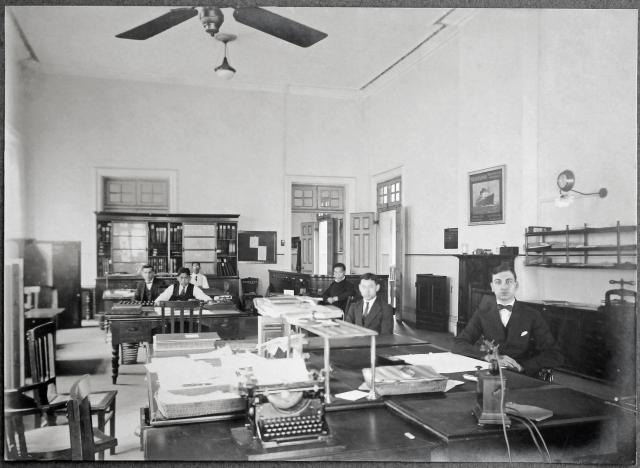Charles Gesner van der Voort had started his career in Rotterdam, at Holland-China Trading Company (HCHC). In 1938, he went to Shanghai for the firm. The Japanese interned him, and most other Dutch nationals, from 1943-45. In camp, he met his wife Nancy and they married after the war. After a leave in The Netherlands, they returned to the Orient, where Charles continued to work for HCHC in Hong Kong.
Twenty years before Charles started, in 1918, a photo album was made of the Hong Kong office and office staff.
First from the right: J.Th. de Vries. Suggestions for names of the other people are welcome.
There are typical office materials on this photo, such a typewriter and an archaic telephone. A poster can be seen of Stoomvaart Maatschappij Nederland, or Nederland Royal Mail Line.
<a href="https://en.wikipedia.org/wiki/Netherland_Line" rel="noreferrer nofollow">en.wikipedia.org/wiki/Netherland_Line</a>:
"The Stoomvaart Maatschappij Nederland ("Netherlands Steamship Company") or SMN, also known as the Netherland Line or Nederland Line, was a Dutch shipping line that operated from 1870 until 1970, when it merged with several other companies to form what would become Royal Nedlloyd. The company's motto, Semper Mare Navigandum ("Always sail the seas"), conveniently fitted the same initials.
The SMN was founded on May 13th, 1870 in Amsterdam for the trade between North Western Europe and the former Dutch East Indies (modern Indonesia) via the newly opened Suez Canal. One of the founders was Prince Hendrik, nicknamed "The Seafarer".
Initially all transport to and from the East Indies was by mail boat. These vessels carried passengers, mail and some freight, and a fast and regular service was required. Passengers from or for Holland often went by train to and from Naples, Marseilles or Genoa in order to keep the travelling time as short as possible.
In the early days the company profited from shipping goods produced by the government-run plantations and industries in the East Indies, from Bangka tin to tobacco and copra. From Europe came manufactured goods, factory equipment and railroad materials.
From 1870 to 1879 the company used its own warehouses in Den Helder (Nieuwediep) for loading and unloading. With the 1876 opening of the Noordzeekanaal (North Sea Canal) connecting Amsterdam directly to the North Sea an easier route to its home base became available. The Oostelijke Handelskade (Eastern Trade dock, 1883–1910) and the Java and Sumatra docks became the center of the SMN in The Netherlands. In Europe ships called regularly at Amsterdam, Southampton and Genoa. In the Dutch East Indies ships plied mainly to the ports on the northern coast of the island of Java, e.g. Jakarta (then known as Batavia), Surabaya and Tanjung Priok. Coal was regularly taken at Valletta, Port Said, Aden, Colombo and Sabang.
In the early decades of the 20th century the company opened new routes operating across the Pacific Ocean between Java and the American West Coast, and, via the Panama Canal, between Java and New York City.
After the mail boats came more specialised vessels: freighters (some with passenger accommodation) and the widely known passenger liners, including famous ships such as Pieter Corneliszoon Hooft (launched 1925), Christiaan Huygens (1927), Johan van Oldenbarnevelt (1929), and Oranje (1938)."
1256 N.V. Internationale Crediet- en Handelsvereniging Rotterdam/C.V. en N.V. Wm H. Muller & Co. (Internatio-Muller N.V.) 1402 Foto album van kantoren in China.
courtesy Stadsarchief Rotterdam, <a href="http://www.stadsarchief.rotterdam.nl/en" rel="noreferrer nofollow">www.stadsarchief.rotterdam.nl/en</a>
Source: This image came from Flickr, see https://flickr.com/photo.gne?id=47923719437
